8-Bit Battle! The Tandy Color Computer 2 vs. the Sega SC-3000
I recently got two new computers. And usually, I might consider doing a “Nicole Buys Stuff”. But those are, well, a bit boring. It’s kind of why I’ve stopped doing them. So how do we make this a little more interesting? Let’s pit two random unrelated computers with completely different architectures against each other!
Meet our competitors
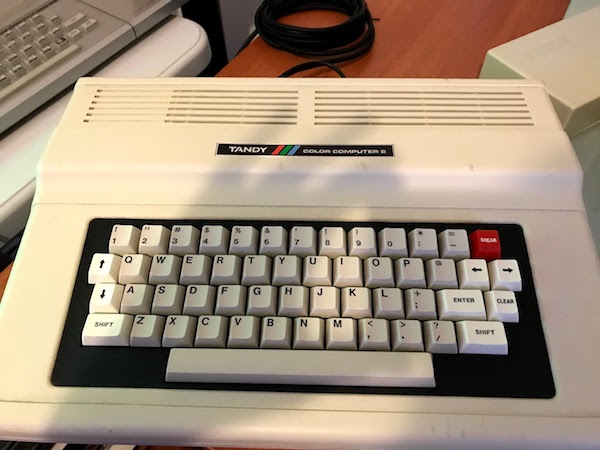
In our first corner, the Tandy Color Computer 2, CoCo to her friends, was made in 1985 by Tandy Corporation based on the 1980 Color Computer, but with a full-travel keyboard, a cost-reduced case, and of course, the Tandy logo. This can be seen as a predecessor to the Tandy 1000 HX we covered earlier, but though this one uses the same joystick ports, pretty much nothing else is compatible.
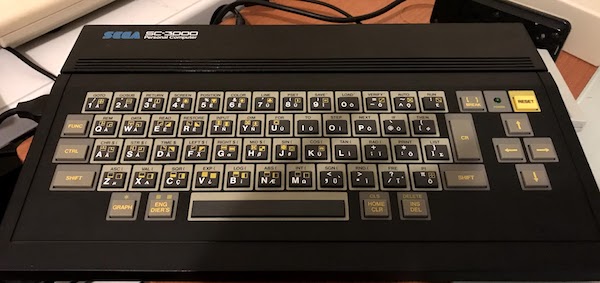
And in the other corner, sporting a very classy black case, is the Sega SC-3000. A 1983 design, this happens to be a PAL model, probably sold in Thailand judging by a faded stamp on the serial number badge. (It was also sold to me by someone who thought it was an NTSC machine; but we have converters for that now) This machine was released alongside Sega’s first game console, the SG-1000; in fact, apparently this design preceded the SG-1000. It’s got some interesting features; for example, the BASIC comes on a cartridge.
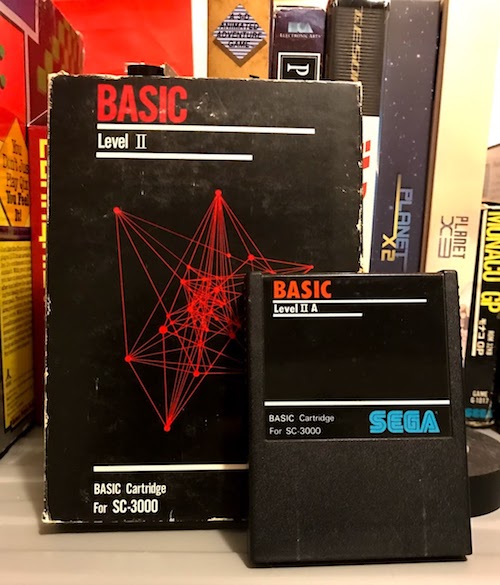
How is this duel going to work?
We’re going to go through a number of totally arbitrary categories, give them all equal importance, and whoever gets more, wins. Not a fair fight? No, no it isn’t. But Markdown-lint is complaining about me putting a question mark at the end of a heading, so let’s get right to it.
Also, I’m mostly going to be comparing these specific machines. This isn’t always fair, and I’ll try to point that out. But none of this is fair. Just have fun with it!
Design
The later beige-plastic Tandy machines are never something I’ve considered lookers; while the grey and black earlier ones had a nice retro-future look, the CoCo 2 is just a bit overly rounded. But I’m biased; unlike many 80’s computer nerds, I don’t like the beige look. Give me a dark plastic case any day.
Oh, what’s that? Sega has that? SC-3000 wins this, I’m afraid.
Keyboard
The SC-3000 has a chiclet keyboard, and when I saw it in pictures I expected it wouldn’t be that bad; the Timex Sinclair 2068 plastic buttons certainly aren’t the world’s best keyboard, but they are definitely usable.
Unfortunately, those aren’t plastic chiclets, they’re rubber. Think ZX Spectrum instead. And yes, Sega came out with a full-travel SG-3000H later, and the original Color Computer 1 had a chiclet keyboard. Don’t care. Tandy takes the prize without breaking a sweat. Which is good, as salt water is conductive and very bad for computers.
Display
The Tandy only has an RF output. That’s really enough to disqualify it; you could point out the Motorola VDG’s 32-column text mode and only eight colors vs. the TMS9929A in the Sega’s 40 columns with 16 colors, and the Sega’s hardware sprites… but really, there are just two points here:
- Sega was (and is) a video game company. Graphics are going to be more important to them than to Tandy and Motorola, who began work on what became the Color Computer to make a cheap agricultural terminal.
- The Sega has composite out.
Sega SC-3000 by a mile.
CPU
The Tandy came with a 895 kHz– yes, that’s right, kHz– Motorola 6809, while the Sega came with a 4 MHz Zilog Z80. No contest, right?
However, if you haven’t heard of the Motorola 6809, you might have heard of its predecessor, the Motorola 6800. Another processor that was, shall we say, inspired by the 6800 is the MOS Technology 6502, which has been well-known to be clock-for-clock substantially more efficient than the Zilog. The 6809E in the Tandy is a more advanced iteration, with multiple accumulators, more instructioons, and limited 16-bit capabilities.
So we’ll have to come back to performance. Let’s call it a tie. (I will say, though, that the 6809 is the thing I find most interesting about the Tandy by far)
RAM
The CoCo 2 has 64KB of RAM. Pretty standard for its time. The SC-3000, on the other hand, has 2KB of RAM. That’s just laughable. The NES had that much RAM! Tandy wins this one– even the original CoCo had 4KB of RAM!
Now, to be fair here, the SC-3000 was designed to do all its expandability over cartridge ports. If I had BASIC Level III B, I could have a 32 KB machine. But since I only have Level II A, no extra RAM is there. The SF-7000 expansion unit, which included a floppy drive, had 64 KB onboard. And if you find one, let me know, because they are hard as hell to find.
Also, the TMS9929A has its own dedicated 16KB of VRAM, so really that 2KB is more like 18KB. Still doesn’t beat the Tandy, but at least looks a little better up against the CoCo 1. The TI 99/4A, which used the same video chip, only had 256 bytes of “work” RAM, relying instead on the VRAM even for things like BASIC programs. So Sega was more generous than it might seem. Still, accessing the VRAM is slower than RAM directly on the system bus.
BASIC
They both use Microsoft BASIC, so it’s a tie. By this time it was the standard, the days of custom BASICs like TRS-80 Level I or Integer BASIC had long gone. (It is worth noting that Atari BASIC and Sinclair BASIC are not Microsoft-based, but these machines are not Atari or Sinclair, are they?)
Biggest cartridges

This one surprised me; the SC-3000 cartridges feel bigger in the hand, but comparing them, the Sega is just slightly wider, and the Tandy cartridges, though landscape rather than portrait, are slightly thicker. So it’s a tie, but I will give the Tandy cartridges props for the cool little sliding plastic protectors on the end.
Smallest cartridges
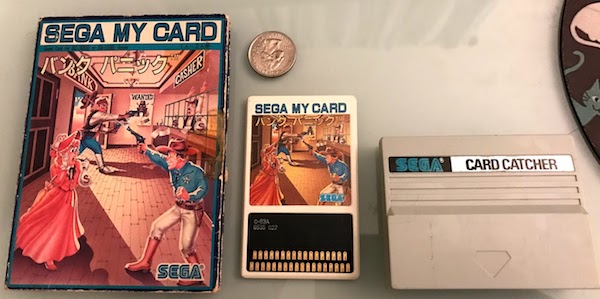
Funny story about those cartridges. Sega gave up on them pretty early in the system’s life, releasing the “Card Catcher”, and then releasing all subsequent releases on “Sega My Card” format. These are very small indeed; exactly the same as the Sega Card format in the US. Almost like they were the same… Sega ties for biggest and wins for smallest.
Joysticks
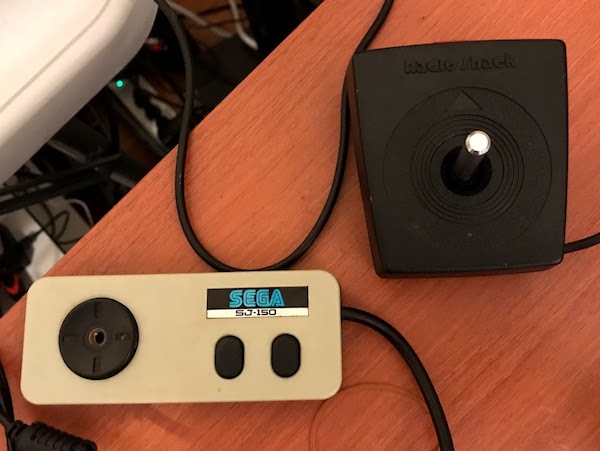
What I have is a gamepad for the later SG-1000 Mark II, but I think it’s close enough, given that the SC-3000 is compatible with literally all Mark II software. What I have for the Tandy is the very common Radio Shack joystick.
The Sega has two buttons, and I prefer gamepads to joysticks. Still, since the Tandy has analog input, I’d give it a tie… except it’s not self-centering. (People say non-self-centering is better for some games, but I can’t stand it in general) Tandy did sell a Deluxe Joystick, but these cheaper ones seem to be much more common. The video game company wins the joystick contest. Who would’ve guessed.
Successors
The Sega SC-3000, as a computer, was a dead end. Oh, the SG-1000 line continued with the Mark III, which became the Master System, and some backwards compatibility from there lasted into the Mega Drive; but those were strictly game machines. Essentially, the SG-1000 had some great successors; but this isn’t an SG-1000.
The CoCo 2 was succeeded by the CoCo 3, a better computer in pretty much every way, with composite and even RGB video out, an improved graphics processor, and up to 512KB of RAM. This made the 8-bit machine competitive well into the 16-bit era.
Tandy takes this one.
Performance
We went over CPU and RAM, but those are just numbers. (Well, ‘Z80’ is numbers and a letter, but) What’s a good test of real world performance that can compare two machines with completely different architectures?
Well, I don’t have one of those. What I have is the Nicole Simulator, which you might remember from the Tandy article. Both these computers use Microsoft BASIC, and neither has an operating system getting in the way like the PC BASIC had with MS-DOS, so this isn’t the worst option.
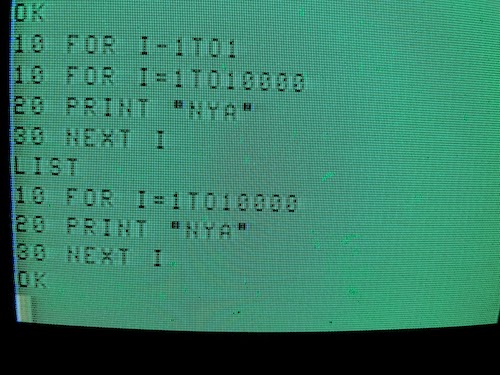
First off, the Tandy. Ugh, that black on green is so ugly, I hope the Sega is at least prettier.
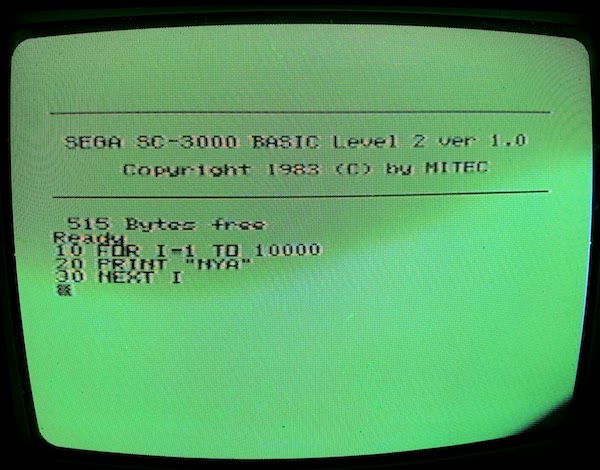
Nope, they also went with the black on green. (At least do green on black!) 515 bytes free is pretty hilariously low. But it’s enough for this, at least.
But who cares about pretty pictures (everyone), let’s see the results! (no one cares about that) I’ll also bring in the results from the last nya benchmark run.
| Computer | CPU | Clock speed | Time to 10K nya (mm:ss) |
|---|---|---|---|
| Apple ][plus | MOS 6502 | 1 MHz | 3:22 |
| Tandy 1000 HX | Intel i8088 | 7.16 MHz | 4:39 |
| Tandy 1000 HX | NEC V20 | 7.16MHz | 4:05 |
| Sega SC-3000 | Zilog Z80 | 4.00MHz | 9:54 |
| Tandy Color Computer 2 | Motorola 6809A | 895kHz | 1:47 |
…Wow. Yeah, this stunned me too; the Tandy Color Computer destroyed the Sega utterly, and every other machine on the list too. I’m not sure if this is because of the 6809 CPU, or because its terminal origins makes it really good at printing text onto a screen, but this is a massive win for Tandy, and well-earned.
The Sega, meanwhile, got left in the dust even by the machines that had to go through MS-DOS. It’d be interesting to compare to a 4MHz CP/M machine, where BASIC also had to go through an OS, to get a real comparison. But that 9 minutes was long enough that I considered giving up.
Who won?
| Computer | Victories |
|---|---|
| Sega SC-3000 | XXXX |
| Tandy Color Computer 2 | XXXX |
| Ties | XXX |
Wow, it’s a tie! It’s almost like I planned it to be! But to be honest, I didn’t. This superficial comparison isn’t the best way to compare machines, sure, but I hope it was fun to see.
